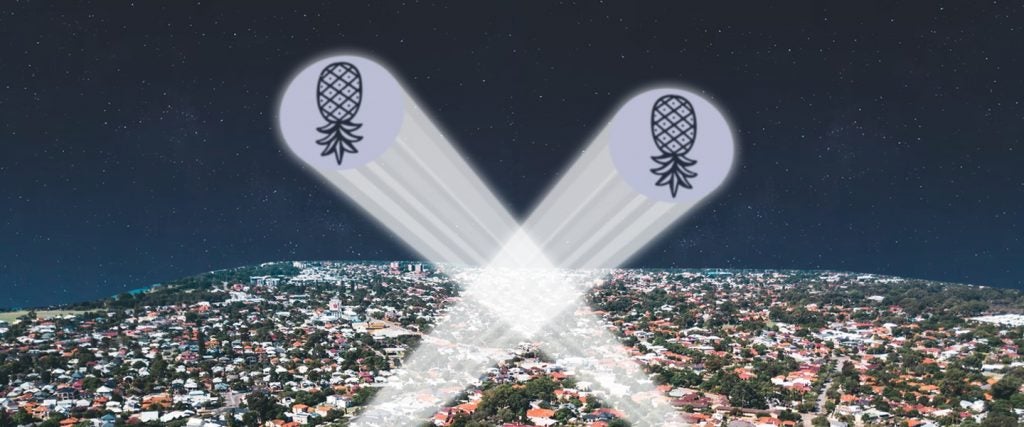When Greg and his wife attend swinger sex parties, there tends to be somewhat of an unspoken dress code. Yes, there are nice pants and sexy lingerie galore, but there’s also an unexpected fruit that seems to make a thematic reappearance. “There’s always a few pineapple-patterned Hawaiian shirts, dresses and socks,” Greg, a pseudonym, tells me.
It depends on who you ask, but it’s kink canon at this point that swingers have adopted the humble pineapple — usually turned upside-down — as a so-called signal. Apparently, open-minded couples across the U.S. in particular wear the fruit as a badge of honor, a symbol that they’re proud swingers and a cue to like-minded couples that they’re down to fuck.
It’s not just pineapples, either. From flamingo lawn ornaments and black jewelry to white rocks and pampas grass laid out on the porch, the internet is full of rumored swinger signals. Yet none of them are more popular than the spiky, juicy citrus fruit — it’s an affiliation so pervasive that merch companies churn out stickers, doormats and T-shirts with upside-down pineapples splashed across them, marketed specifically at swingers.
But reactions from swingers themselves are mixed. Some see these signals on a regular basis and know what they mean, while others think it’s total bullshit invented by vanilla communities in a clickbait grab to sensationalize swinger lifestyles.
So, which is it?
As 38-year-old swinger Matt (also a pseudonym) tells me, there’s an element of truth in every rumor. “Plenty of folks do use the upside-down pineapple as a symbol that they’re in the lifestyle,” he tells me. “You’ll see plenty of people at hotel takeovers and swinger cruises who wear them on their clothing, or they’ll have bags, purses and towels that contain them.” Some RV-owning swingers even hang pineapple flags from their vehicles at campsites, or slap stickers across their rigs. Matt explains that this functions as both a flag and a possible invitation — it’s a coded cue designed to start conversations, and potentially sexy trysts.
The first time travel blogger Jenni, who writes under the alias “Cruise Mummy,” stumbled across the pineapple’s sordid reputation was in the private Facebook group of an upcoming cruise vacation she planned to take. “A man posted in the group to ask if anyone wanted to meet up on the ship, and he’d included the pineapple emoji in his post,” she tells me. “In the comments, I saw another person had explained that it was a swingers’ symbol. I guess that caused a few people to hastily delete their replies!”
Tickled by the encounter, she subsequently wrote a blog post describing the pineapple as “the definitive secret code for swinging,” and says more people are learning about this hidden history “thanks to funny memes shared in Facebook groups.” “Even now, whenever I see someone wearing pineapple-printed clothes on a [vanilla] cruise, I think to myself, I wonder if they know,” she says.
What is the history behind it, though? For the most part, it seems unclear. Fifty-nine-year-old swinger Geoff (yep, a pseudonym) says he’s seen “many different symbols, including black rings, necklaces with numerous different pendants and yard symbols [like garden gnomes]” come and go as swinger code. He speculates that these unofficial swinger signifiers were born out of a desire to find potential play partners in “vanilla environments, like a grocery store or the mall.”
All of this is plausible given that swinging swelled in popularity way before the internet. The practice dates back to at least the 1950s, when wealthy Air Force officers would move their wives closer to their military bases. But given their high fatality rates, pilots would sometimes “swap” their spouses, seeing non-monogamy as a potential solution to the impending, never-ending threat of being injured or killed at work. Thus, the practice of “wife-swapping” was born, and it continued to pick up steam throughout the sexual revolution of the 1960s.
Pineapples themselves have an interesting history that could play a factor too, which is rooted deeply in colonization. According to an investigation by Atlas Obscura, European colonizers in the Caribbean loved the tangy fruits, and made a point of bringing them to the U.S, starting in the late 15th century. In the Caribbean, homes that were seemingly “welcoming to strangers” hung pineapples in their front entrances. When families that were rich enough to afford pineapples in the U.S. — at this point, they were an “exotic,” far-flung delicacy — heard these stories, they started to see the fruit as a prestigious symbol of hospitality.
There’s no hard evidence to back this up, but swingers could have adopted the pineapple as a symbol to signal they were “welcoming to strangers.” By turning it upside-down, they might have hinted at their own sexy, subversive spin on hospitality.
That said, the pineapple is far from ubiquitous. Greg says he’s never seen an earnest use of them, and sociology professor Michelle Wolkomir has spent years researching swingers as part of an academic publication on gender relations in swinger relationships. Yet when I ask about the mythical pineapple, she says she’s never heard of it being used as a swinging signal at all.
Whether there’s a historical paper trail or not, swingers often lean into the humor of these fabled, so-called symbols. A Belgian swinger who asks to remain anonymous explains, “They’re such a widespread inside joke that you could almost consider them actual swinger symbols. Not that they’re used as ‘secret messages’ to attract other swingers, but some people do look for clothing, accessories or other gadgets with these images because of the hidden meaning.”
Basically, swingers have staked their tongue-in-cheek claim on the symbol to fuck with regular folk and wryly nod toward their kinky lifestyles.
Mostly, though, the dozen or so swingers I speak to agree that the upside-down pineapple symbol is an urban legend that’s since been adopted as an in-joke. As for other so-called symbols — the white rocks, the pampas grass, the wedding rings worn on right hands — Matt believes they’re total bullshit, too. “As far as I’m concerned, all other ‘symbols’ are far too common and completely unreliable as any sort of lifestyle identifier,” he concludes. “Hell, even my elderly mother has garden gnomes, pink flamingos and white rocks around her front yard, and she’s the farthest thing from a swinger you’ll ever meet.”
Instead, swingers rely on private community events and their own corners of the internet to meet. According to Ed, a seasoned swinger and co-host of podcast Swinger University, “The best way to connect with other swingers is to do swinger things,” he tells me. “Put yourself in sexy situations like nudist resorts, boat days, hot tub/pool parties, and obviously, swinger events. It’s pretty much the only guaranteed situation, even though there are plenty of other times where swinger behavior can occur.”
If there so happens to be a piña colada or two there, more power to you.

